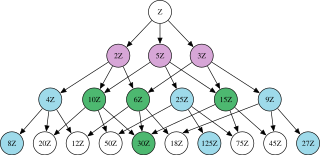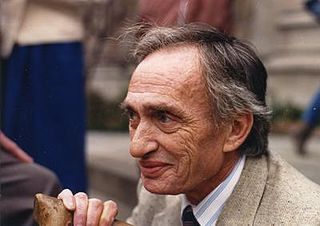
In algebra, a prime ideal is a subset of a ring that shares many important properties of a prime number in the ring of integers. The prime ideals for the integers are the sets that contain all the multiples of a given prime number, together with the zero ideal.
In commutative algebra, the Krull dimension of a commutative ring R, named after Wolfgang Krull, is the supremum of the lengths of all chains of prime ideals. The Krull dimension need not be finite even for a Noetherian ring. More generally the Krull dimension can be defined for modules over possibly non-commutative rings as the deviation of the poset of submodules.
In mathematics, a Noetherian ring is a ring that satisfies the ascending chain condition on left and right ideals; if the chain condition is satisfied only for left ideals or for right ideals, then the ring is said left-Noetherian or right-Noetherian respectively. That is, every increasing sequence of left ideals has a largest element; that is, there exists an n such that:
In mathematics, more specifically in ring theory, local rings are certain rings that are comparatively simple, and serve to describe what is called "local behaviour", in the sense of functions defined on varieties or manifolds, or of algebraic number fields examined at a particular place, or prime. Local algebra is the branch of commutative algebra that studies commutative local rings and their modules.

Commutative algebra, first known as ideal theory, is the branch of algebra that studies commutative rings, their ideals, and modules over such rings. Both algebraic geometry and algebraic number theory build on commutative algebra. Prominent examples of commutative rings include polynomial rings; rings of algebraic integers, including the ordinary integers ; and p-adic integers.

In algebra, ring theory is the study of rings—algebraic structures in which addition and multiplication are defined and have similar properties to those operations defined for the integers. Ring theory studies the structure of rings, their representations, or, in different language, modules, special classes of rings, as well as an array of properties that proved to be of interest both within the theory itself and for its applications, such as homological properties and polynomial identities.
In ring theory, a branch of mathematics, a radical of a ring is an ideal of "not-good" elements of the ring.
In mathematics, especially in the area of abstract algebra known as module theory, a semisimple module or completely reducible module is a type of module that can be understood easily from its parts. A ring that is a semisimple module over itself is known as an Artinian semisimple ring. Some important rings, such as group rings of finite groups over fields of characteristic zero, are semisimple rings. An Artinian ring is initially understood via its largest semisimple quotient. The structure of Artinian semisimple rings is well understood by the Artin–Wedderburn theorem, which exhibits these rings as finite direct products of matrix rings.
In mathematics, coherent duality is any of a number of generalisations of Serre duality, applying to coherent sheaves, in algebraic geometry and complex manifold theory, as well as some aspects of commutative algebra that are part of the 'local' theory.
In mathematics, specifically commutative algebra, a proper ideal Q of a commutative ring A is said to be primary if whenever xy is an element of Q then x or yn is also an element of Q, for some n > 0. For example, in the ring of integers Z, (pn) is a primary ideal if p is a prime number.
In mathematics, the Köthe conjecture is a problem in ring theory, open as of 2022. It is formulated in various ways. Suppose that R is a ring. One way to state the conjecture is that if R has no nil ideal, other than {0}, then it has no nil one-sided ideal, other than {0}.
In mathematics, more specifically ring theory, a left, right or two-sided ideal of a ring is said to be a nil ideal if each of its elements is nilpotent.
In algebra, a Hilbert ring or a Jacobson ring is a ring such that every prime ideal is an intersection of primitive ideals. For commutative rings primitive ideals are the same as maximal ideals so in this case a Jacobson ring is one in which every prime ideal is an intersection of maximal ideals.

Israel Nathan Herstein was a mathematician, appointed as professor at the University of Chicago in 1951. He worked on a variety of areas of algebra, including ring theory, with over 100 research papers and over a dozen books.
In mathematics, more specifically ring theory, an ideal I of a ring R is said to be a nilpotent ideal if there exists a natural number k such that I k = 0. By I k, it is meant the additive subgroup generated by the set of all products of k elements in I. Therefore, I is nilpotent if and only if there is a natural number k such that the product of any k elements of I is 0.
In mathematics, more specifically ring theory and the theory of nil ideals, Levitzky's theorem, named after Jacob Levitzki, states that in a right Noetherian ring, every nil one-sided ideal is necessarily nilpotent. Levitzky's theorem is one of the many results suggesting the veracity of the Köthe conjecture, and indeed provided a solution to one of Köthe's questions as described in. The result was originally submitted in 1939 as, and a particularly simple proof was given in.

In mathematics, a noncommutative ring is a ring whose multiplication is not commutative; that is, there exist a and b in the ring such that ab and ba are different. Equivalently, a noncommutative ring is a ring that is not a commutative ring.
In abstract algebra, a uniserial moduleM is a module over a ring R, whose submodules are totally ordered by inclusion. This means simply that for any two submodules N1 and N2 of M, either or . A module is called a serial module if it is a direct sum of uniserial modules. A ring R is called a right uniserial ring if it is uniserial as a right module over itself, and likewise called a right serial ring if it is a right serial module over itself. Left uniserial and left serial rings are defined in an analogous way, and are in general distinct from their right counterparts.
Kevin Mor McCrimmon is an American mathematician, specializing in Jordan algebras. He is known for his introduction of quadratic Jordan algebras in 1966.
Wallace Smith Martindale III is an American mathematician, known for Martindale's Theorem (1969) and the Martindale ring of quotients introduced in the proof of the theorem. His 1969 paper generalizes Posner's theorem and a theorem of Amitsur and gives an independent, unified proof of the two theorems.




